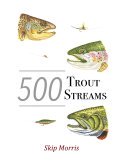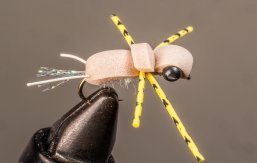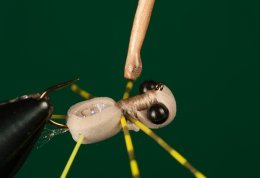Soft Hackle Fly vs Wet Fly
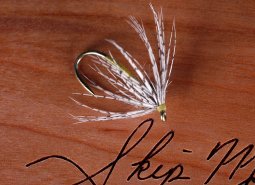 The Partridge and Yellow, tied by Skip Morris.
The Partridge and Yellow, tied by Skip Morris.
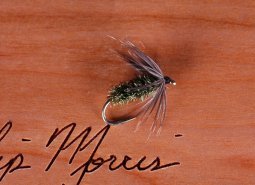 The Starling and Herl, tied by Skip Morris.
The Starling and Herl, tied by Skip Morris.
Soft Hackle Fly vs Wet Fly. A good many fly fishers are probably still uncertain about how a wet fly differs from a soft-hackled fly, and if the differences are even worth bothering with.
Wet fly, soft-hackled fly, it’s really all the same, isn’t it?
No, actually it’s not. Though it can be.
Different Retrieves for Different Flies
Look, here’s the simple explanation, or at least half of it.
- The wet fly is normally fished with the traditional wet-fly swing (and sometimes
with a twitching action)—at least a fairly lively retrieve of the fly overall. - The soft-hackled fly is fished on a very subtle retrieve with an across- or even slightly upstream cast and plenty of line-mending to work the fly ever so slightly.
A modest to lively retrieve versus a very slow retrieve—
see the difference now?
However, I did say that the two fly types can be treated the same, and that’s true.
The wet fly can be and sometimes is fished in very slow soft-hackle fashion, even, occasionally, dead drift. Still, lively is the norm.
The soft-hackled fly? I’ve never seen one fished quickly. One could be, of course, but its design makes it a poor choice for such work.
All this begs the question that may already have occurred to you:
why are these two similar fly-styles fished differently?
Good question.
And its answer completes the explanation about
how wet flies and soft-hackled flies differ.
It's All in the Design
So, the answer to the question is this: the wet fly and soft-hackled fly are fished differently, in part, because they are designed to be fished differently.
- Wet flies have hackle-fibers of standard length, fibers that are supple, yes, but stiff enough not to lie pinned by a good push of water—stiff enough to bounce on an active against-the-current retrieve. The sort of current and retrieve that would put a straitjacket on a soft-hackle fly.
- But soft-hackle flies require a different sort of hackle for the quiet retrieves and light currents for which they are intended. Soft-hackled flies have long, supple hackle fibers, the sort that wave like delicate legs when the pressure of water against them is light and varied.
- So for soft-hackled flies, you need hackle with especially soft fibers—hen saddle (hen neck is okay, but a bit stiff—better for wet flies), partridge flank, starling, and such.
So that's how I see this whole soft-hackle versus wet-fly business, and my view comes from decades of tying and fishing both kinds of flies.
My view conflicts with some of the literature, however, yet it agrees with a lot of it, too. That's fine with me—I never expect to have the last word on anything, wet flies and soft-hackles included. Still, I know that if you fish these flies as I've described, they'll take trout, including some very cagey ones.
And, all else aside, a few decades of hands-on experience ought to count for something...
Tying Soft Hackled Flies
A body and a hackle—that’s all there is to most soft-hackled flies.
So when tying such flies you won’t often be bothered with adding a lot of common fly components—tail, wings, tag, rib...
Consequently, soft-hackle fly patterns are pretty easy to tie.
Of course, not all soft-hackled fly patterns are the same; if they were, there would be only one. Some do have ribs, some have bodies of floss or herl or dubbing, and so on.
Despite all the variations, the two patterns we’ll tie—the Partridge and Yellow and the Starling and Herl—are fairly typical soft-hackle fly patterns and should provide a good introduction.
As you’d expect, the hackle of a soft-hackle is the critical element for the tier, and for the effectiveness of the finished fly.
Fiber-length is the first order of business.
Based on my own experience, and a bit of research, I’ve concluded that the hackle for a soft-hackle fly should have fibers equal to the full length of the hook, or slightly shorter.
A hackle that matches, on a hackle gauge,
a hook two sizes larger than the one you’re using will be correct.
You can bind the hackle on by its tip, so that when you wrap that hackle its longest fibers will be in front (as I’ll demonstrate with the Partridge and Yellow).
By wrapping the hackle back to the front of the body and then winding the thread forward through the hackle (as I’ll demonstrate with the Starling and Herl), the longest fibers end up in front too; and better yet, turns of thread will cross and reinforce the fragile stem, resulting in a hackle collar that is tough.
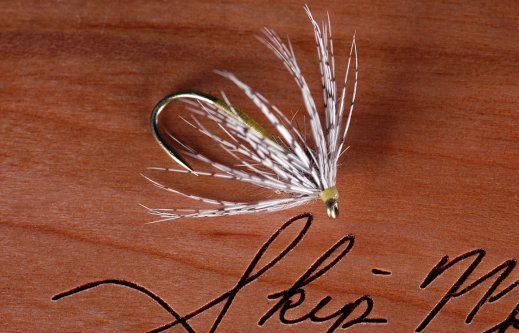 The Partridge and Yellow, tied by Skip Morris.
The Partridge and Yellow, tied by Skip Morris.
Partridge and Yellow
- Hook: Heavy wire, 1X long, sizes 18 to 10.
- Thread: Yellow 6/0 or 8/0.
- Abdomen: Yellow floss.
- Thorax: Hare’s mask fur.
- Hackle: Gray partridge (or substitute hen saddle hackle).
Tying the Partridge and Yellow:
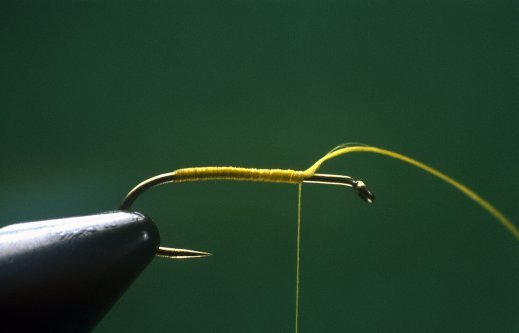 The Partridge and Yellow, tying Step 1.
The Partridge and Yellow, tying Step 1.
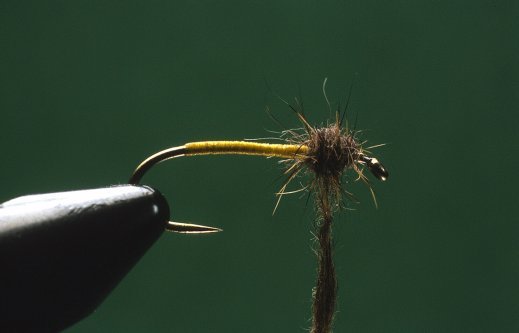 The Partridge and Yellow, tying Step 2.
The Partridge and Yellow, tying Step 2.
2. Spin some hare’s mask dubbing onto the thread, and then dub a thick, short thorax over the front third of the shank. (Leave a little bare shank behind the hook’s eye, for the hackle and thread head.)
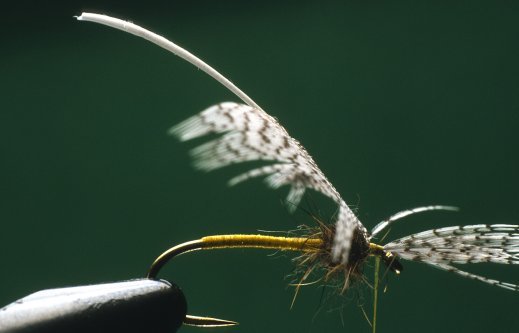 The Partridge and Yellow, tying Step 3.
The Partridge and Yellow, tying Step 3.
3. Find a gray partridge feather of appropriate size for your hook. (For more on hackle-fiber length for soft-hackle flies, see “Tying Soft-Hackle Flies” on the previous page.) Stroke the fibers back from the tip of the feather, and then bind the feather at the front of the thorax by that tip. Wind the thread forward to just behind the eye.
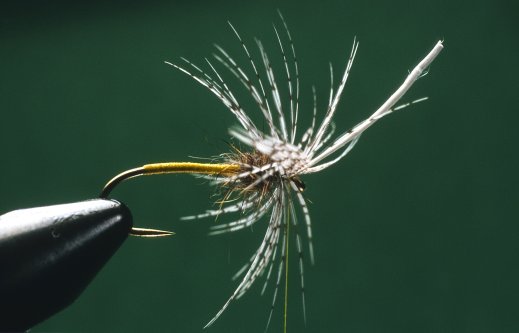 The Partridge and Yellow, tying Step 4.
The Partridge and Yellow, tying Step 4.
4. Trim away the tip of the feather. Wind the feather forward in two to four close turns (depending on how full you want the hackle). Bind the butt of the feather with a few tight thread-turns just behind the eye. Trim off the stem.
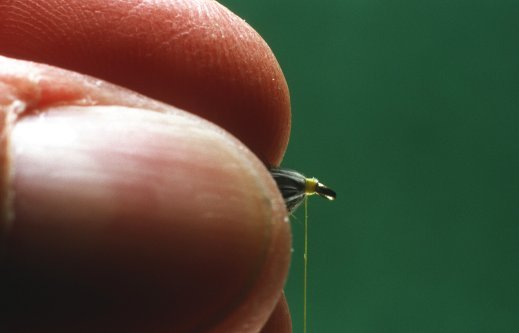 The Partridge and Yellow, tying Step 5.
The Partridge and Yellow, tying Step 5.
5. Stroke all the partridge fibers back from the eye. build a tapered thread-head, whip finish and trim the thread, and then add head cement to the thread-head to complete the Partridge and Yellow.
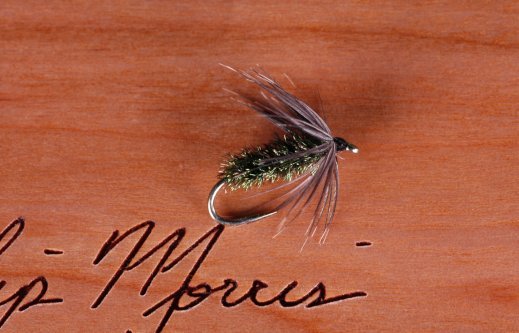 The Starling and Herl, tied by Skip Morris.
The Starling and Herl, tied by Skip Morris.
Starling and Herl
- Hook: Heavy wire, 1X long, sizes 18 to 14.
- Thread: Black 6/0 or 8/0.
- Body: Peacock herl.
- Hackle: Starling body feather with iridescent sheen.
Tying the Starling and Herl:
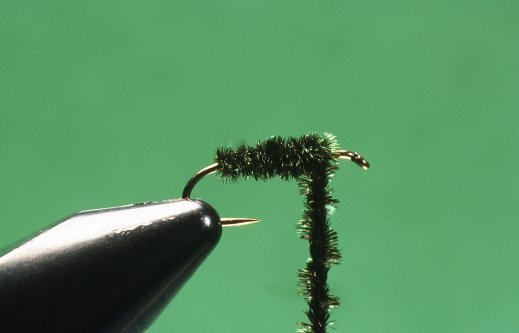 Starling and Herl, tying Step 1.
Starling and Herl, tying Step 1.
1. Here’s how to tie the Starling and Herl. Start the thread at about the center of the shank; then spiral the thread back to the bend. At the bend, bind on a few peacock herls. Spin the herls and working thread together to form a sort of herl rope. Wind this rope up the shank to just short of the eye. There, unwind the herl from the thread and bind the herl with a few tight thread-turns. Trim the ends of the herl closely.
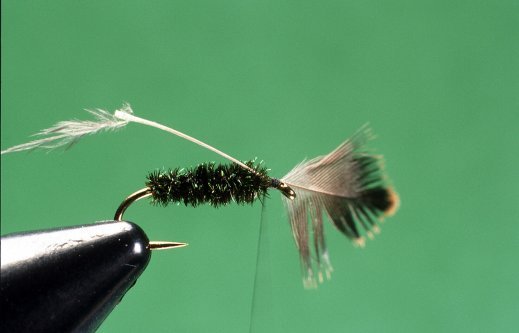 Starling and Herl, tying Step 2.
Starling and Herl, tying Step 2.
2. Here’s another way to wrap a hackle on a soft-hackled fly. Find a starling feather of appropriate size (as described on the previously page under “Tying Soft-Hackle Flies.”). Strip the fibers from the base of the feather. Bind the feather right behind the hook’s eye; then wind the thread back to the front of the body. Trim off the feather’s stem.
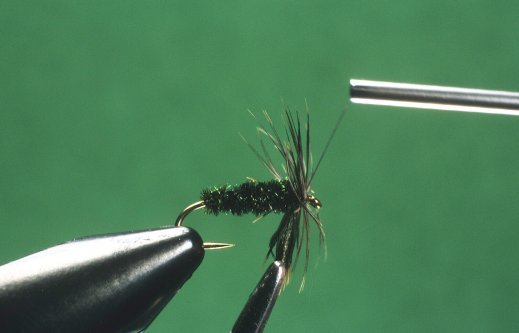 Starling and Herl, tying Step 3.
Starling and Herl, tying Step 3.
3. Wind the hackle in two to four close turns back to the front of the body; then spiral the thread forward through the hackle to the eye. Find and then trim out the feather’s tip. Build and complete a thread head as described previously for the Partridge and Yellow to complete the Starling and Herl.
And this concludes Skip's article on the Soft Hackle fly vs the Wet fly.
*Note: this article is taken from the book Morris on Tying Flies, reprinted here with permission from Frank Amato Publications, Inc.
Click here to hear Skip's interviews on popular podcasts...
*Announcements*
Skip has an essay in Big Sky Journal's annual Fly Fishing issue, called "Montana Hoppers: the Princess and the Brute" released February 1, 2023. Skip rewrote it a bit; I painted and illustrated it here, on our website. Here's the link on our web page to check it out:
Click here to read Skip's essay Montana Hoppers: The Princess and the Brute...
Skip's latest books:
Top 12 Dry Flies for Trout Streams: How, When, and Where to Fish Them, is now available on Amazon as an ebook...check it out! Click on the links below to go to the information page on Top 12 Dry Flies (the link to Amazon is at the bottom of the page...)
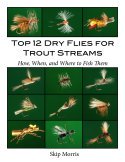 Top 12 Dry Flies for Trout Streams: How, When, and Where to Fish Them
Top 12 Dry Flies for Trout Streams: How, When, and Where to Fish Them
Click here to get more information about
Top 12 Dry Flies for Trout Streams: How, When, and Where to Fish Them (the link to Amazon is at the bottom of the page)...
Top 12 Dry Flies for Trout Streams: How, When, and Where to Fish Them (the link to Amazon is at the bottom of the page)...
Top 12 Nymphs for Trout Streams: How, When, and Where to Fish Them, 2nd Edition, originally published as an e-book only, is now available on Amazon as a paperback...check it out! Click on the links below to go to the information page on Top 12 Nymphs (the link to Amazon is at the bottom of the page...)
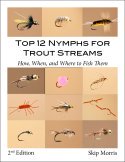 Top 12 Nymphs for Trout Streams: How, When, and Where to Fish Them (2nd Edition)
Top 12 Nymphs for Trout Streams: How, When, and Where to Fish Them (2nd Edition)
Click here to get more information about
Top 12 Nymphs for Trout Streams: How, When, and Where to Fish Them (2nd Edition). . .
Top 12 Nymphs for Trout Streams: How, When, and Where to Fish Them (2nd Edition). . .
Click here to get more information about Skip's e-book,
500 Trout Streams...
500 Trout Streams...
Skip's latest paperback book:
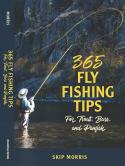 365 Fly Fishing Tips for Trout, Bass, and Panfish
365 Fly Fishing Tips for Trout, Bass, and Panfish
Click here to get more information about Skip's latest book,
365 Tips for Trout, Bass, and Panfish...
365 Tips for Trout, Bass, and Panfish...
Print Skip's chart for FREE:
Skip Morris's Trout-Fly Proportion Chart
Go to Skip Morris's Trout Fly Proportion Chart
Skip's Predator is available to buy...
Skip's ultra-popular Predator—a hit fly for bluegills and other panfishes and largemouth bass (also catches smallmouth bass and trout)—is being tied commercially by the Solitude Fly Company.
The Predator
CLICK HERE to learn more about or to purchase the Predator...
Learn to Tie Skip's Predator
Do you want to tie the Predator?
Tying the Predator
Skip shows you how to tie it on his YouTube Channel link, listed below:
CLICK HERE to see Skip's detailed video on how to tie the Predator...






